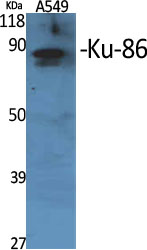CD270 (HVEM, TR2)-FC recombinant protein
- Catalog No.:YD3015
- Reactivity:Human;
- Purity:
- >90% as determined by SDS-PAGE
- Gene Name:
- TNFRSF14
- Protein Name:
- Tumor necrosis factor receptor superfamily member 14 (Herpes virus entry mediator A) (Herpesvirus entry mediator A) (HveA) (Tumor necrosis factor receptor-like 2) (TR2) (CD antigen CD270)
- Sequence:
- Amino acid:39-202,with FC tag.
- Human Gene Id:
- 8764
- Human Swiss Prot No:
- Q92956
- Formulation:
- Phosphate-buffered solution
- Source:
- Mammalian cells
- Storage Stability:
- -15°C to -25°C/1 year(Avoid freeze / thaw cycles)
- Other Name:
- Tumor necrosis factor receptor superfamily member 14 ;Herpes virus entry mediator A;Herpesvirus entry mediator A;HveA;Tumor necrosis factor receptor-like 2;TR2;CD antigen CD270;TNFRSF14;HVEA;HVEM;UNQ329/PRO509;
- Function:
- Receptor for four distinct ligands: The TNF superfamily members TNFSF14/LIGHT and homotrimeric LTA/lymphotoxin-alpha and the immunoglobulin superfamily members BTLA and CD160, altogether defining a complex stimulatory and inhibitory signaling network (PubMed:10754304, PubMed:18193050, PubMed:23761635, PubMed:9462508). Signals via the TRAF2-TRAF3 E3 ligase pathway to promote immune cell survival and differentiation (PubMed:19915044, PubMed:9153189, PubMed:9162022). Participates in bidirectional cell-cell contact signaling between antigen presenting cells and lymphocytes. In response to ligation of TNFSF14/LIGHT, delivers costimulatory signals to T cells, promoting cell proliferation and effector functions (PubMed:10754304). Interacts with CD160 on NK cells, enhancing IFNG production and anti-tumor immune response (PubMed:23761635). In the context of bacterial infection, acts as a signalin
- Subcellular Location:
- Cell membrane ; Single-pass type I membrane protein .
- Expression:
- Widely expressed, with the highest expression in lung, spleen and thymus. Expressed in a subpopulation of B cells and monocytes (PubMed:18193050). Expressed in naive T cells (PubMed:19915044).
- June 19-2018
- WESTERN IMMUNOBLOTTING PROTOCOL
- June 19-2018
- IMMUNOHISTOCHEMISTRY-PARAFFIN PROTOCOL
- June 19-2018
- IMMUNOFLUORESCENCE PROTOCOL
- September 08-2020
- FLOW-CYTOMEYRT-PROTOCOL
- May 20-2022
- Cell-Based ELISA│解您多样本WB检测之困扰
- July 13-2018
- CELL-BASED-ELISA-PROTOCOL-FOR-ACETYL-PROTEIN
- July 13-2018
- CELL-BASED-ELISA-PROTOCOL-FOR-PHOSPHO-PROTEIN
- July 13-2018
- Antibody-FAQs

